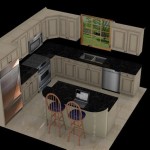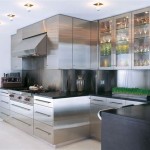Kitchens With Pendant Lights Over Island: A Comprehensive Guide
Kitchen islands have become a staple in modern kitchen design, serving as functional workspaces, social gathering spots, and aesthetic focal points. Integrated lighting is crucial for enhancing the island's usability and visual appeal. Pendant lights, suspended from the ceiling, offer both task lighting and decorative flair, making them a popular choice above kitchen islands. This article explores various aspects of incorporating pendant lights into kitchen island design, encompassing style considerations, installation guidelines, and practical applications.
Understanding the Function and Benefits of Pendant Lights
Pendant lights provide localized, focused illumination, making them ideal for task lighting over a kitchen island. When placed strategically, they can brighten work surfaces for food preparation, reading recipes, or engaging in other activities. Beyond functionality, pendant lights contribute significantly to the kitchen's overall aesthetic. They come in a diverse range of styles, materials, and finishes, allowing homeowners to personalize the space and complement existing décor. Furthermore, pendant lights can define the island as a distinct zone within the kitchen, creating visual separation and enhancing the sense of space. Properly selected and positioned pendant lights enhance both the functionality and beauty of a kitchen island, elevating the entire kitchen experience.
The advantages of using pendant lights extend beyond mere illumination. They can:
- Provide direct task lighting for food preparation and other activities.
- Act as a decorative element, enhancing the kitchen's overall aesthetic.
- Define the island as a separate zone within the kitchen space.
- Offer a wide range of styles and materials to suit different design preferences.
- Be easily customized in terms of height and spacing to meet specific needs.
Selecting the Right Style and Material
The selection of pendant lights should be based on the overall style of the kitchen and the homeowner's personal preferences. There is a wide array of options available, each with its own unique characteristics. For a modern kitchen, minimalist pendant lights with clean lines and simple shapes may be appropriate. These lights often feature materials like brushed nickel, stainless steel, or glass. In contrast, a traditional kitchen might benefit from pendant lights with ornate details, such as wrought iron, antique brass, or fabric shades. Rustic kitchens can incorporate pendant lights made from natural materials like wood, copper, or woven fibers.
Material choice is another crucial consideration. Glass pendant lights diffuse light beautifully, creating a soft and inviting ambiance. Metal pendant lights offer durability and can add a touch of industrial chic. Fabric shades provide warmth and texture, while natural materials like wood or bamboo can bring an organic element to the kitchen. When selecting pendant lights, it is important to consider the existing hardware and fixtures in the kitchen. Matching the finish of the pendant lights to the cabinet hardware, faucet, and other metal accents can create a cohesive and harmonious design.
Some popular pendant light styles include:
- Mini pendants: Small, compact lights that are ideal for smaller islands or for creating a clustered effect.
- Bowl pendants: Feature a bowl-shaped shade that directs light downwards.
- Globe pendants: Spherical lights that offer a contemporary and elegant look.
- Linear pendants: Long, rectangular lights that are perfect for larger islands.
- Industrial pendants: Rugged and utilitarian lights that often feature exposed bulbs and metal cages.
Determining the Correct Size, Spacing, and Height
Selecting the appropriate size, spacing, and height for pendant lights above a kitchen island is crucial for achieving both optimal functionality and aesthetic appeal. The size of the pendant lights should be proportional to the size of the island. For a small island, smaller pendants are generally more suitable, while larger islands can accommodate larger pendants. Avoid using oversized pendants above a small island, as this can overwhelm the space. Conversely, using undersized pendants above a large island may make them appear insignificant.
The spacing between pendant lights should be consistent and balanced. A general guideline is to space them approximately 24 to 30 inches apart, depending on the size and style of the pendants. The goal is to achieve even illumination across the entire island surface. Consider the overall width of the island and divide it by the desired number of pendants to determine the appropriate spacing. If the island is particularly long, more pendants may be necessary to ensure adequate lighting.
The height at which pendant lights are suspended is equally important. The bottom of the pendant lights should typically be 30 to 36 inches above the island countertop. This height allows for ample headroom and prevents the lights from obstructing views across the kitchen. However, the ideal height may vary depending on the height of the ceilings and the size of the pendants. In kitchens with higher ceilings, the pendants can be hung slightly lower to create a more intimate and inviting atmosphere. It's advisable to consider adjusting the height of the pendants until the perfect visual balance is achieved.
Factors influencing size, spacing and height:
- Island size and shape
- Ceiling height
- Desired level of illumination
- Style of the pendant lights
- Visual preferences of the homeowner
Installation Considerations and Electrical Requirements
Installing pendant lights typically involves basic electrical work, which should ideally be performed by a qualified electrician. Ensuring the safety of the electrical installation is paramount. Before beginning the installation process, it is essential to turn off the power to the circuit at the breaker box. Verifying that the power is off using a voltage tester is an important safety measure.
The first step in the installation process is to locate the electrical box in the ceiling. This is where the pendant light will be connected to the electrical wiring. If an electrical box is not already present, one will need to be installed. The electrical box provides a secure and stable mounting point for the pendant light. Once the electrical box is located, the pendant light can be wired according to the manufacturer's instructions. Typically, this involves connecting the black wire to the black wire, the white wire to the white wire, and the ground wire to the ground wire.
After the wiring is complete, the pendant light can be attached to the electrical box using the provided mounting hardware. Make sure the pendant light is securely fastened to the ceiling to prevent it from falling. Adjust the height of the pendant light to the desired level. Once the pendant light is installed and the height is adjusted, turn the power back on at the breaker box and test the light to ensure it is working properly.
Important electrical considerations:
- Ensure the electrical circuit is properly grounded.
- Use appropriate wire gauge for the electrical load.
- Make sure the electrical box is rated for the weight of the pendant light.
- Follow all local electrical codes and regulations.
Integrating Pendant Lights with Other Kitchen Lighting
Pendant lights above a kitchen island should be integrated into a comprehensive kitchen lighting plan that incorporates various layers of illumination. These layers typically include ambient lighting, task lighting, and accent lighting. Ambient lighting provides overall illumination for the kitchen, while task lighting focuses on specific work areas, such as the island. Accent lighting highlights architectural features or decorative elements. Pendant lights primarily function as task lighting over the island, but they can also contribute to the overall ambiance of the kitchen.
Recessed lighting is often used as the primary source of ambient lighting in a kitchen. These lights are installed flush with the ceiling, providing even and unobtrusive illumination. Under-cabinet lighting is another important component of a well-designed kitchen lighting plan. These lights are installed under the upper cabinets, providing focused task lighting for countertops and work surfaces. Accent lighting can be achieved through the use of track lighting, spotlights, or decorative wall sconces. These lights can be used to highlight artwork, architectural details, or other focal points in the kitchen.
When integrating pendant lights with other kitchen lighting, it is important to consider the color temperature of the light sources. Color temperature refers to the warmth or coolness of the light, measured in Kelvin (K). Warmer light sources have a lower color temperature (e.g., 2700K), while cooler light sources have a higher color temperature (e.g., 5000K). Using light sources with similar color temperatures can create a more cohesive and harmonious lighting design. For example, if the recessed lighting has a color temperature of 3000K, it would be advisable to select pendant lights with a similar color temperature.

Kitchen Island Lighting Dowsing Reynolds

How Many Pendants For A Kitchen Island Elesi Blog

Pendant Lighting Over The Kitchen Island A Simple Guide

Design Ideas For The Ultimate Entertaining Kitchen

Lighting A Kitchen Island 10 Tips For Choosing The Perfect Pendant Company

Kitchen Island Lighting Jim Lawrence Handcrafted Quality

Stained Glass Pendant Lamp For Over Kitchen Island Sea Ceiling Light Fixture Lights Etsy

Tips For Kitchen Island Pendant Lighting Simple Blog

Lighting A Kitchen Island 10 Tips For Choosing The Perfect Pendant Company

Pendant Light Spacing Sizing For Kitchen Islands Modern Place








